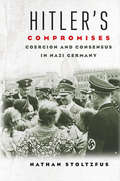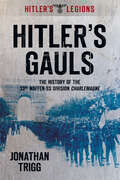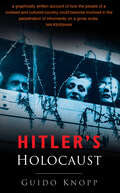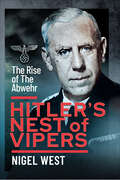- Table View
- List View
Hitler and Churchill: Secrets of Leadership
by Andrew Roberts'His book is timely and a triumph. Roberts manages to convey all the reader needs to know about two men to whom battalions of biographies have been devoted' EVENING STANDARDAdolf Hitler and Winston Churchill were two totally opposite leaders - both in what they stood for and in the way in which they seemed to lead. Award-winning historian Andrew Roberts examines their different styles of leadership and draws parallels with rulers from other eras. He also looks at the way Hitler and Churchill estimated each other as leaders, and how it affected the outcome of the war. In a world that is as dependent on leadership as any earlier age, HITLER AND CHURCHILL asks searching questions about our need to be led. In doing so, Andrew Roberts forces us to re-examine the way that we look at those who take decisions for us.
Hitler and Spain: The Nazi Role in the Spanish Civil War
by Robert H. Whealey“An imperative starting point of any future inquiry concerning Nazi Germany’s incursion into and manipulation of Spain’s civil strife.” —International History ReviewThe Spanish Civil War, begun in July 1936, was a preliminary round of World War II. Hitler’s and Mussolini’s cooperation with General Franco resulted in the Axis agreement of October 1936 and the subsequent Pact of Steel of May 1939, immediately following the end of the Civil War.This study presents comprehensive documentation of Hitler’s use of the upheaval in Spain to strengthen the Third Reich diplomatically, ideologically, economically, and militarily. While the last great cause drew all eyes to Western Europe and divided the British and especially the French internally, Hitler could pursue territorial gains in Eastern Europe.This book, based on little-known German records and recently opened Spanish archives, fills a major gap in our understanding of one of the twentieth century’s most significant conflicts. Its comprehensive treatment of German-Spanish relations from 1936 through 1939, bringing together diplomatic, economic, military, and naval aspects, will be of great value to specialists in European diplomacy and the political economy of Nazi imperialism, as well as to all students of the Spanish Civil War.“A major contribution to understanding not only the Spanish conflict, but also the history of the thirties and, in particular, the failure of Britain, France and the Soviet Union to make common cause against fascist powers.” —History Workshop Journal
Hitler and Stalin: Parallel Lives
by Alan BullockForty years after his Hitler: A Study in Tyranny set a standard for scholarship of the Nazi era, Lord Alan Bullock gives readers a breathtakingly accomplished dual biography that places Adolf Hitler's origins, personality, career, and legacy alongside those of Joseph Stalin--his implacable antagonist and moral mirror image.
Hitler and his Women
by Phil CarradiceThis unique biography examines Hitler&’s many female relationships, from his mother and sisters to his girlfriends, secretaries, and adoring public. To most of the world, Adolf Hitler was a ranting, evil demagogue whose insane ambitions caused incalculable harm to humanity. But to the women in his life, he was kind, compassionate, and loving—a man to be admired and adored. In Hitler and His Women, historian Phil Carradice explores the Fuhrer&’s many relationships with women, from his romantic involvements to his interactions with female staff and the thousands of women who flocked to hear him speak. While many are familiar with Eva Braun, she was not alone in her role as the Fuhrer&’s lover. Dozens of women preceded her, including Mitzi Reiter, Henny Hoffmann, and his own niece Geli Raubal. To them and many others, Hitler was the ultimate romantic. From deep familial bonds to a teenage infatuation with a girl he never met, from actresses like Zara Leander to English aristocrat Unity Mitford, Carradice examines how Hitlers relationships with women affected the course of history.
Hitler and the Habsburgs: The Führer's Vendetta Against the Austrian Royals
by James Longo&“A detailed and moving picture of how the Habsburgs suffered under the Nazi regime…scrupulously sourced, well-written, and accessible.&”—Publishers Weekly (starred review) It was during five youthful years in Vienna that Adolf Hitler's obsession with the Habsburg Imperial family became the catalyst for his vendetta against a vanished empire, a dead archduke, and his royal orphans. That hatred drove Hitler's rise to power and led directly to the tragedy of the Second World War and the Holocaust. The royal orphans of Archduke Franz Ferdinand—offspring of an upstairs-downstairs marriage that scandalized the tradition-bound Habsburg Empire—came to personify to Adolf Hitler, and others, all that was wrong about modernity, the twentieth century, and the Habsburgs&’ multi-ethnic, multi-cultural Austro-Hungarian Empire. They were outsiders in the greatest family of royal insiders in Europe, which put them on a collision course with Adolf Hitler. As he rose to power Hitler's hatred toward the Habsburgs and their diverse empire fixated on Franz Ferdinand's sons, who became outspoken critics and opponents of the Nazi party and its racist ideology. When Germany seized Austria in 1938, they were the first two Austrians arrested by the Gestapo, deported to Germany, and sent to Dachau. Within hours they went from palace to prison. The women in the family, including the Archduke's only daughter, Princess Sophie Hohenberg, declared their own war on Hitler. Their tenacity and personal courage in the face of betrayal, treachery, torture, and starvation sustained the family during the war and in the traumatic years that followed. Through a decade of research and interviews with the descendants of the Habsburgs, scholar James Longo explores the roots of Hitler's determination to destroy the family of the dead Archduke—and uncovers the family members' courageous fight against the Führer.
Hitler at Home
by Despina StratigakosA look at Adolf Hitler&’s residences and their role in constructing and promoting the dictator&’s private persona both within Germany and abroad. Adolf Hitler&’s makeover from rabble-rouser to statesman coincided with a series of dramatic home renovations he undertook during the mid-1930s. This provocative book exposes the dictator&’s preoccupation with his private persona, which was shaped by the aesthetic and ideological management of his domestic architecture. Hitler&’s bachelor life stirred rumors, and the Nazi regime relied on the dictator&’s three dwellings—the Old Chancellery in Berlin, his apartment in Munich, and the Berghof, his mountain home on the Obersalzberg—to foster the myth of the Führer as a morally upstanding and refined man. Author Despina Stratigakos also reveals the previously untold story of Hitler&’s interior designer, Gerdy Troost, through newly discovered archival sources. At the height of the Third Reich, media outlets around the world showcased Hitler&’s homes to audiences eager for behind-the-scenes stories. After the war, fascination with Hitler&’s domestic life continued as soldiers and journalists searched his dwellings for insights into his psychology. The book&’s rich illustrations, many previously unpublished, offer readers a rare glimpse into the decisions involved in the making of Hitler&’s homes and into the sheer power of the propaganda that influenced how the world saw him.&“Inarguably the powder-keg title of the year.&”—Mitchell Owen, Architectural Digest&“A fascinating read, which reminds us that in Nazi Germany the architectural and the political can never be disentangled. Like his own confected image, Hitler&’s buildings cannot be divorced from their odious political hinterland.&”—Roger Moorhouse, Times
Hitler e Estaline: Os Tiranos e a Segunda Guerra Mundial
by Laurence ReesO conceituado historiador Laurence Rees mergulha nas profundezas dos regimes cruéis de Hitler e Estaline e mostra até que ponto os dois homens brutalizaram o mundo à sua volta. Dois ditadores do século XX distinguem-se pelo impacto e crueldade que tiveram no mundo. Aliados por um curto período de tempo durante a Segunda Guerra Mundial, Hitler e Estaline tentaram depois exterminar-se mutuamente em campanhas de guerra nunca vistas no mundo moderno, afetando soldados e civis de igual modo. Quilómetros sem fim da Europa de Leste foram arruinados neste combate mortal e milhões de vidas foram sacrificadas. Recorrendo a testemunhos inéditos de soldados do Exército Vermelho e da Wehrmacht, de civis que sofreram durante o conflito e daqueles que conheceram pessoalmente os dois homens, esta obra-prima — o culminar de 30 anos de trabalho — do autor bestseller Laurence Rees, um dos melhores historiadores contemporâneos, analisa o percurso dos dois tiranos durante a Segunda Guerra Mundial, quando a Alemanha e a União Soviética travaram a maior e mais sangrenta guerra da História, demonstrando que, apesar de ferozes adversários, Hitler e Estaline eram, em grande medida, os dois lados de uma mesma moeda. «Da autoria de um dos mais conceituados especialistas na Segunda Guerra Mundial, este é um relato importante, original — e devastador — de Hitler e Estaline como ditadores.» Robert Service, autor de Estaline — Uma Biografia «Neste estudo fascinante de dois monstros, Laurence Rees é extraordinariamente percetivo e original.» Sir Antony Beevor, autor de Estalinegrado «Laurence Rees combina de forma brilhante testemunhos poderosos, uma narrativa vívida e uma análise irrefutável neste soberbo relato de como dois terríveis ditadores lideraram os seus países na guerra mais destrutiva e desumana da História.» Sir Ian Kershaw, autor de Hitler «Um trabalho extraordinário e de grande coragem. Revelador, fascinante e extremamente relevante, mostra Hitler e Estaline como nunca foram mostrados. Uma verdadeira história do nosso tempo, com tantas lições a retirar para o mundo conturbado em que vivemos hoje que irá revolucionar o entendimento que temos destes dois tiranos.» Damien Lewis, autor de The Nazi Hunters
Hitler versus Hindenburg
by Larry Eugene JonesHitler versus Hindenburg provides the first in-depth study of the titanic struggle between the two most dominant figures on the German Right in the last year before the establishment of the Third Reich. Although Hindenburg was reelected as Reich president by a comfortable margin, his authority was severely weakened by the fact that the vast majority of those who had supported his candidacy seven years earlier had switched their support to Hitler in 1932. What the two candidates shared in common, however, was that they both relied upon charisma to legitimate their claim to the leadership of the German nation. The increasing reliance upon charisma in the 1932 presidential elections greatly accelerated the delegitimation of the Weimar Republic and set the stage for Hitler's appointment as chancellor nine months later.
Hitler's American Friends: The Third Reich's Supporters in the United States
by Bradley W. HartA book examining the strange terrain of Nazi sympathizers, nonintervention campaigners and other voices in America who advocated on behalf of Nazi Germany in the years before World War II.Americans who remember World War II reminisce about how it brought the country together. The less popular truth behind this warm nostalgia: until the attack on Pearl Harbor, America was deeply, dangerously divided.Bradley W. Hart's Hitler's American Friends exposes the homegrown antagonists who sought to protect and promote Hitler, leave Europeans (and especially European Jews) to fend for themselves, and elevate the Nazi regime. Some of these friends were Americans of German heritage who joined the Bund, whose leadership dreamed of installing a stateside Führer. Some were as bizarre and hair-raising as the Silver Shirt Legion, run by an eccentric who claimed that Hitler fulfilled a religious prophesy. Some were Midwestern Catholics like Father Charles Coughlin, an early right-wing radio star who broadcast anti-Semitic tirades. They were even members of Congress who used their franking privilege—sending mail at cost to American taxpayers—to distribute German propaganda. And celebrity pilot Charles Lindbergh ended up speaking for them all at the America First Committee.We try to tell ourselves it couldn't happen here, but Americans are not immune to the lure of fascism. Hitler's American Friends is a powerful look at how the forces of evil manipulate ordinary people, how we stepped back from the ledge, and the disturbing ease with which we could return to it.
Hitler's Atrocities Against Allied PoWs: War Crimes of the Third Reich
by Philip D. Chinnery“A chilling description of the ordeals that captured men and women were put through by the Third Reich regime and their Italian allies.” —Daily MailSeventy years ago, the Nuremberg Trials were in full swing in Germany. In the dock were the leaders of the Nazi regime and most eventually received their just desserts. But what happened to the other war criminals?In June 1946, Lord Russell of Liverpool became Deputy Judge Advocate and legal adviser to the Commander in Chief for the British Army of the Rhine in respect of all trials held by British Military Courts of German war criminals. He later wrote:“At the outbreak of the Second World War, the treatment of prisoners was governed by the Geneva Prisoner of War Convention of 1929, the Preamble of which stated that the aim of the signatories was to alleviate the conditions of prisoners of war.“During the war, however, the provisions of the Convention were repeatedly disregarded by Germany. Prisoners were subjected to brutality and ill-treatment, employed on prohibited and dangerous work, handed over to the SD for ‘special treatment’ in pursuance of Hitler’s Commando Order, lynched in the streets by German civilians, sent to concentration camps, shot on recapture after escaping, and even massacred after they had laid down their arms and surrendered.”Tens of thousands of Allied prisoners of war died at the hands of the Nazis and their Italian allies. This book is for them lest we forget.“A sobering and harrowing book, detailing many forgotten crimes committed against POWs who should have been offered the protection of the Geneva Convention, but tragically were not.” —Recollections of WWII
Hitler's Berlin
by Stewart SpencerFrom his first visit to Berlin in 1916, Hitler was preoccupied and fascinated by Germany's great capital city. In this vivid and entirely new account of Hitler's relationship with Berlin, Thomas Friedrich explores how Hitler identified with the city, how his political aspirations were reflected in architectural aspirations for the capital, and how Berlin surprisingly influenced the development of Hitler's political ideas. A leading expert on the twentieth-century history of Berlin, Friedrich employs new and little-known German sources to track Hitler's attitudes and plans for the city. Even while he despised both the cosmopolitan culture of the Weimar Republic and the profound Jewish influence on the city, Hitler was drawn to the grandiosity of its architecture and its imperial spirit. He dreamed of transforming Berlin into a capital that would reflect his autocracy, and he used the city for such varied purposes as testing his anti-Semitic policies and demonstrating the might of the Third Reich. Illuminating Berlin's burdened years under Nazi subjection, Friedrich offers new understandings of Hitler and his politics, architectural views, and artistic opinions.
Hitler's Charisma: Leading Millions into the Abyss
by Laurence ReesFuelled by hate, incapable of forming normal human relationships, unwilling to listen to dissenting voices, Adolf Hitler seemed an unlikely leader, and yet he commanded enormous support and was able to exert a powerful influence over those who encountered him. How did Hitler become such an attractive figure to millions of people? That is the question at the core of Hitler's Charisma. Acclaimed historian and documentary filmmaker Laurence Rees examines the nature of Hitler's appeal and reveals the role his supposed "charisma" played in his success. Here is a fascinating social, psychological and historical investigation into the formation of a personality whose determination and vision would at the outset convince a small group of like-minded political and social outcasts but would eventually win over an entire nation and plunge the rest of the world into a cataclysm unlike any that had ever been seen before. Hitler's Charisma is a natural culmination of twenty years of writing and research on the Third Reich and a remarkable examination of the man and the mind at the heart of it all.(With 16 pages of black-and-white illustrations)
Hitler's Compromises: Coercion and Consensus in Nazi Germany
by Nathan StoltzfusHistory has focused on Hitler's use of charisma and terror, asserting that the dictator made few concessions to maintain power. Nathan Stoltzfus, the award-winning author of Resistance of Heart: Intermarriage and the Rosenstrasse Protest in Germany, challenges this notion, assessing the surprisingly frequent tactical compromises Hitler made in order to preempt hostility and win the German people's complete fealty. As part of his strategy to secure a "1,000-year Reich," Hitler sought to convince the German people to believe in Nazism so they would perpetuate it permanently and actively shun those who were out of step with society. When widespread public dissent occurred at home--which most often happened when policies conflicted with popular traditions or encroached on private life--Hitler made careful calculations and acted strategically to maintain his popular image. Extending from the 1920s to the regime's collapse, this revealing history makes a powerful and original argument that will inspire a major rethinking of Hitler's rule.
Hitler's Cosmopolitan Bastard: Count Richard Coudenhove-Kalergi and His Vision of Europe
by Martyn BondIn the turbulent period following the First World War the young Count Richard Coudenhove-Kalergi founded the Pan-European Union, offering a vision of peaceful, democratic unity for Europe, with no borders, a common currency, and a single passport. His political congresses in Vienna, Berlin, and Basel attracted thousands from the intelligentsia and the cultural elite, including Albert Einstein, Thomas Mann, and Sigmund Freud, who wanted a United States of Europe brought together by consent. The Count's commitment to this cooperative ideal infuriated Adolf Hitler, who referred to him as a "cosmopolitan bastard" in Mein Kampf.Communists and nationalists, xenophobes and populists alike hated the Count and his political mission. When the Nazis annexed Austria, the Count and his wife, the famous actress Ida Roland, narrowly escaped the Gestapo. He fled to the United States, where he helped shape American policy for postwar Europe. Coudenhove-Kalergi's profile was such that he served as the basis for the fictional resistance hero Victor Laszlo in the film Casablanca.A brilliant networker, the Count guided many European leaders, notably advising Winston Churchill before his 1946 Zürich speech on Europe. A friend to both Chancellor Konrad Adenauer and President Charles de Gaulle, Coudenhove-Kalergi was personally invited to the High Mass in Rheims Cathedral in 1961 to celebrate Franco-German reconciliation. A provocative visionary for Europe, Coudenhove-Kalergi thought and acted in terms of continents, not countries.For the Count, the United States of Europe was the answer to the challenges of communist Russia and capitalist America. Indeed, he launched his Pan-European Union thirty years before Jean Monnet set up the European Coal and Steel Community, the precursor to the European Union. Timely and capitivating, Martyn Bond's biography offers an opportunity to explore a remarkable life and revisit the impetus and origins of a unified Europe.
Hitler's Empire: How the Nazis Ruled Europe
by Mark MazowerDrawing on an unprecedented variety of sources, Mark Mazower reveals how the Nazis designed, maintained, and ultimately lost their European empire and offers a chilling vision of the world Hitler would have made had he won the war. Germany's forces achieved, in just a few years, the astounding domination of a landmass and population larger than that of the United States. Control of this vast territory was meant to provide the basis for Germany's rise to unquestioned world power. Eastern Europe was to be the Reich's Wild West, transformed by massacre and colonial settlement. Western Europe was to provide the economic resources that would knit an authoritarian and racially cleansed continent together. But the brutality and short-sightedness of Nazi politics lost what German arms had won and brought their equally rapid downfall. Time and again, the speed of the Germans' victories caught them unprepared for the economic or psychological intricacies of running such a far-flung dominion. Politically impoverished, they had no idea how to rule the millions of people they suddenly controlled, except by bludgeon. Mazower forces us to set aside the timeworn notion that the Nazis' worldview was their own invention. Their desire for land and their racist attitudes toward Slavs and other nationalities emerged from ideas that had driven their Prussian forebears into Poland and beyond. They also drew inspiration on imperial expansion from the Americans and especially the British, whose empire they idolized. Their signal innovation was to exploit Europe's peoples and resources much as the British or French had done in India and Africa. Crushed and disheartened, many of the peoples they conquered collaborated with them to a degree that we have largely forgotten. Ultimately, the Third Reich would be beaten as much by its own hand as by the enemy. Throughout this book are fascinating, chilling glimpses of the world that might have been. Russians, Poles, and other ethnic groups would have been slaughtered or enslaved. Germans would have been settled upon now empty lands as far east as the Black Sea--the new "Greater Germany. " Europe's treasuries would have been sacked, its great cities impoverished and recast as dormitories for forced laborers when they were not deliberately demolished. As dire as all this sounds, it was merely the planned extension of what actually happened in Europe under Nazi rule as recounted in this authoritative, absorbing book.
Hitler's First Hundred Days: When Germans Embraced the Third Reich
by Peter FritzscheThis unsettling and illuminating history reveals how Germany's fractured republic gave way to the Third Reich, from the formation of the Nazi party to the rise of Hitler.Amid the ravages of economic depression, Germans in the early 1930s were pulled to political extremes both left and right. Then, in the spring of 1933, Germany turned itself inside out, from a deeply divided republic into a one-party dictatorship. In Hitler's First Hundred Days, award-winning historian Peter Fritzsche offers a probing account of the pivotal moments when the majority of Germans seemed, all at once, to join the Nazis to construct the Third Reich. Fritzsche examines the events of the period -- the elections and mass arrests, the bonfires and gunfire, the patriotic rallies and anti-Jewish boycotts -- to understand both the terrifying power the National Socialists exerted over ordinary Germans and the powerful appeal of the new era they promised.Hitler's First Hundred Days is the chilling story of the beginning of the end, when one hundred days inaugurated a new thousand-year Reich.
Hitler's Flemish Lions: The History of the SS-Freiwilligan Grenadier Division Langemarcke (Flamische Nr. I) (Hitler's Legions)
by Jonathan TriggBy the end of the Second World War there were soldiers of more than 30 nationalities fighting in the 38 combat division of the Waffen SS; Reich Germans were in the minority. How did a regime founded upon notions of its own racial superiority come to welcome hundreds of thousands of foreigners into its military elite – and what motivated these men?Following the sell-out success of his first volume in this series, Hitler’s Gauls, the author examines in depth the Langemarck division, composed entirely of fighters drawn from the Flemish lands of Northern Belgium. Motivated by a powerful anti-communist zeal and a desire to escape forever the interference of their traditional enemy, France, these men fought at Stalingrad and in the encircling battles of the Volkhov pocket. They fought the bitter campaign in the Ukraine in 1943-44, then in Estonia at the Narva. The Division was destroyed by the Russian juggernaut in1945. Illustrated with rare photographs, many previously unpublished, and with close analysis of the key figures such as Flemish Knight’s Cross winner Remy Schrijnen, this is a fascinating study of fanatical courage.
Hitler's Foreign Executioners: Europe's Dirty Secret
by Christopher HaleIn Hitler’s Foreign Executioners, Heinrich Himmler’s secret master plan for Europe is revealed: an SS empire that would have no place for either the Nazi Party or Adolf Hitler. His astonishingly ambitious plan depended on the recruitment of tens of thousands of ‘Germanic’ peoples from every corner of Europe, and even parts of Asia, to build an ‘SS Europa’. This revised and fully updated book, researched in archives all over Europe and using first-hand testimony, exposes Europe’s dirty secret: nearly half a million Europeans and more than a million Soviet citizens enlisted in the armed forces of the Third Reich to fight a deadly crusade against a mythic foe, Jewish Bolshevism.Even today, some apologists claim that these foreign SS volunteers were merely soldiers ‘like any other’ and fought a decent war against Stalin’s Red Army. Historian Christopher Hale demonstrates conclusively that these surprisingly common views are mistaken. By taking part in Himmler’s murderous master plan, these foreign executioners hoped to prove that they were worthy of joining his future ‘SS Europa’. But as the Reich collapsed in 1944, Himmler’s monstrous scheme led to bitter confrontations with Hitler – and to the downfall of the man once known as ‘loyal Heinrich’.
Hitler's Gauls: The History of the 33rd Waffen-SS Division Charlemagne
by Jonathan TriggThe divisions of the Waffen-SS were among the elite of Hitler’s armies in the Second World War. But alongside the Germans in the Waffen-SS fought an astonishingly high number of volunteers from other countries. By the end of the Second World War these foreign volunteers comprised half of all Hitler’s Waffen-SS, and filled the ranks of over twenty-four of the nominal thirty-eight Waffen-SS divisions. So during the most brutal war that mankind has ever known, hundreds of thousands of men flocked to fight for a country that was not theirs, and for a cause that was one of the most monstrous and barbaric in history. Who were these men, and why did they fight? Hitler’s Gauls is an in-depth examination of one of these legions of foreign volunteers, the Charlemagne division, who were recruited entirely from conquered France. The men in Charlemagne, often motivated by an extreme anti-communist zeal, fought hard on the Eastern Front including battles of near annihilation in the snows of Pomerania and the final stand in the ruins of Berlin. This definitive history, illustrated with rare photographs, explores the background, training, key figures and full combat record of one of Hitler’s lesser known foreign units of the Second World War.
Hitler's Generals in America: Nazi POWs and Allied Military Intelligence
by Derek R. MallettThe WWII historian offers &“provocative analysis&” of the US military&’s evolving relationship with German officers held on American soil (Robert D. Billinger Jr., author of Nazi POWs in the Tar Heel State). In Hitler&’s Generals in America, Derek R. Mallett examines the relationship between American officials and the Wehrmacht general officers they held as prisoners of war in the United States between 1943 and 1946. While the British pampered the German officers in their custody in order to obtain intelligence, Americans did not share the same sense of class privilege, and refused any special treatment to German prisoners of any rank. By the end of the war, however, the United States had begun to envision itself as a world power rather than one of several allies providing aid during wartime. Mallett demonstrates how a growing admiration for the German officers&’ prowess and military traditions, coupled with postwar anxiety about Soviet intentions, drove Washington to collaborate with many Wehrmacht general officers. Drawing on newly available sources, this intriguing book shows how Americans undertook the complex process of reconceptualizing Germans—even Nazi generals—as allies against what they perceived as their new enemy, the Soviet Union.
Hitler's Girl: The British Aristocracy and the Third Reich on the Eve of WWII
by Lauren YoungA timely, riveting book that presents for the first time an alternative history of 1930s Britain, revealing how prominent fascist sympathizers nearly succeeded in overturning British democracy—using the past as a road map to navigate the complexities of today’s turn toward authoritarianism.Hitler’s Girl is a groundbreaking history that reveals how, in the 1930s, authoritarianism nearly took hold in Great Britain as it did in Italy and Germany. Drawing on recently declassified intelligence files, Lauren Young details the pervasiveness of Nazi sympathies among the British aristocracy, as significant factions of the upper class methodically pursued an actively pro-German agenda. She reveals how these aristocrats formed a murky Fifth Column to Nazi Germany, which depended on the complacence and complicity of the English to topple its proud and long-standing democratic tradition—and very nearly succeeded.As she highlights the parallels to our similarly treacherous time, Young exposes the involvement of secret organizations like the Right Club, which counted the Duke of Wellington among its influential members; the Cliveden Set, which ran a shadow foreign policy in support of Hitler; and the shocking four-year affair between socialite Unity Mitford and Adolf Hitler.Eye-opening and instructive, Hitler’s Girl re-evaluates 1930s England to help us understand our own vulnerabilities and poses urgent questions we must face to protect our freedom. At what point does complacency become complicity, posing real risk to the democratic norms that we take for granted? Will democracy again succeed—and will it require a similarly cataclysmic event like World War II to ensure its survival? Will we, in our own defining moment, stand up for democratic values—or will we succumb to political extremism?
Hitler's Holocaust
by Guido KnoppNo crime in the twentieth century has so deeply shocked mankind as the Holocaust. And none has so stubbornly resisted every attempt to explain it. More than six million people were murdered, and countless more endured horrific suffering. Guido Knopp's disturbing account is the most complete history of teh Holocaust to date. It reveals the appalling truth using the most recent historical research, including minutes of daily briefings by Joseph Goebbels, private papers of the SS Einsatzgruppen in charge of mass murder, and East German State Security documents detailing the deportation of Jews. The book relives the agony of the victims and investigations the motive of the perpetrators. Survivors talk for the first time about their horrifying torture and their eventual escape from Nazi persecution. The persecutors now at last confront the atrocities they committed. This is not an attempt to rewrite the history of the Holocaust, but a searing account of the greatest crime of the twentieth century - if not of all time - using the latest research on the subject.
Hitler's Home Front: Memoirs of a Hitler Youth
by Don A Gregory Wilhelm R GehlenA &“candid and revealing memoir shows a normal boy and a family at war and in its aftermath, determined to do what it took to survive . . . fascinating&” (The Great War). When Adolf Hitler and the Nazi Party came into power in 1933, he promised the downtrodden, demoralized, and economically broken people of Germany a new beginning and a strong future. Millions flocked to his message, including a corps of young people called the Hitlerjugend—the Hitler Youth. By 1942 Hitler had transformed Germany into a juggernaut of war that swept over Europe and threatened to conquer the world. It was in that year that a nine-year-old Wilhelm Reinhard Gehlen, took the &‘Jungvolk&’ oath, vowing to give his life for Hitler. This is the story of Wilhelm Gehlen&’s childhood in Nazi Germany during World War II and the awful circumstances which he and his friends and family had to endure during and following the war. Including a handful of recipes and descriptions of the strange and sometimes disgusting food that nevertheless kept people alive, this book sheds light on the truly awful conditions and the twisted, mistaken devotion held by members of the Hitler Youth—that it was their duty to do everything possible to save the Thousand Year Reich.
Hitler's Munich: The Capital of the Nazi Movement
by David Ian HallAn acclaimed historian of twentieth century Germany provides a vivid account of Hitler’s rise to power and its intimate connection to the Bavarian capital.The immediate aftermath of the Great War and the Versailles Treaty created a perfect storm of economic, social, political and cultural factors which facilitated the rapid rise of Adolf Hitler’s political career and the birth of the National Socialist German Worker’s Party. The breeding ground for this world-changing evolution was the city of Munich. In Hitler’s Munich, renowned historian David Ian Hall examines the origins and growth of Hitler’s National Socialism through the lens of this unique city. By connecting the sites where Hitler and his accomplices built the movement, Hall offers a clear and concrete understanding of the causes, background, motivation, and structures of the Party. Hitler’s Munich is a cultural and political portrait of the city, a biography of the Fuhrer, and a history of National Socialism. All three interacted in this expertly rendered exploration of their interconnections and significance.
Hitler's Nest of Vipers: The Rise Of The Abwehr
by Nigel West"...presents an excellent and concise narrative of the Abwehr's global intelligence network. West draws from hundreds of firsthand debriefing and summary reports including disclosed sources not previously available to scholars."—American Intelligence JournalModern historians have consistently condemned the Abwehr, Germany’s military intelligence service, and its SS equivalent, the Sicherheitsdienst (SD), as incompetent and even corrupt organizations. However, newly declassified MI5, CIA and US Counterintelligence Corps files shed a very different light on the structure, control and capabilities of the German intelligence machine in Europe, South America, the Mediterranean and the Middle East. It is usually stated that, under Admiral Canaris, the Abwehr neglected its main functions, its attention being focused more on trying to bring down Hitler. Yet Canaris greatly expanded the Abwehr from 150 personnel into a vast world-wide organisation which achieved many notable successes against the Allies. Equally, the SD’s tentacles spread across the Occupied territories as the German forces invaded country after country across Europe. In this in-depth study of the Abwehr’s rise to power, 1935 to 1943, its activities in Russia, the Baltic States, Ukraine, Japan, China, Manchuko and Mongolia are examined, as well as those in Thailand, French Indo-China, the Dutch East Indies, the Philippines, Iran, Turkey, Afghanistan, and the Arab nations. In this period, the Abwehr built a complex network of individual agents with transmitters operating from commercial, diplomatic and consular premises. Before, and in the early stages of the war, it later became apparent, the Abwehr was controlling a number of agents in Britain. Indeed, it was only after the war that the scale of the Abwehr’s activities became known, the organisation having of around 20,000 members. For the first time, the Abwehr’s development and the true extent of its operations have been laid bare, through official files and even of restored documents previously redacted. The long list of operations and activities of the Abwehr around the world includes the efforts of an agent in the USA who was arrested after a bizarre attempt to obtain a quantity of blank American passports by impersonating a senior State Department official, Edward Weston, an Under-Secretary of State. Also, former U.S. Marine, Kurt Jahnke, who was recruited to collect information about the American munitions production and send it on to Germany. These are just two of the numerous and absorbing accounts in this all-embracing study.
























